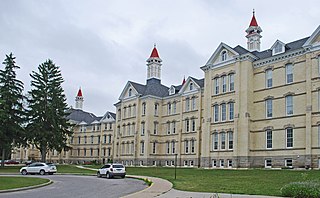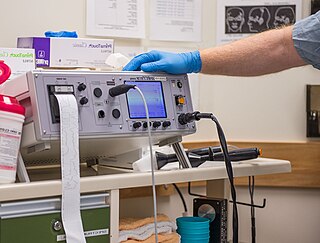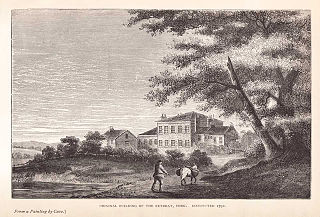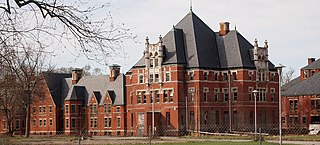
Psychiatric hospitals, also known as mental health hospitals or behavioral health hospitals, are hospitals or wards specializing in the treatment of severe mental disorders, such as schizophrenia, bipolar disorder, eating disorders, dissociative identity disorder, major depressive disorder and many others. Psychiatric hospitals vary widely in their size and grading. Some hospitals may specialize only in short-term or outpatient therapy for low-risk patients. Others may specialize in the temporary or permanent confinement of patients who need routine assistance, treatment, or a specialized and controlled environment due to a psychiatric disorder. Patients often choose voluntary commitment, but those whom psychiatrists believe to pose significant danger to themselves or others may be subject to involuntary commitment and involuntary treatment. Psychiatric hospitals may also be called psychiatric wards/units when they are a subunit of a regular hospital.
McLean Hospital is a psychiatric hospital in Belmont, Massachusetts. It is noted for its clinical staff expertise and neuroscience research and is also known for the large number of famous people who have been treated there. McLean maintains the world's largest neuroscientific and psychiatric research program in a private hospital. It is the largest psychiatric facility of Harvard Medical School, an affiliate of Massachusetts General Hospital, and part of Mass General Brigham, which also includes Brigham and Women's Hospital.

Electroconvulsive therapy (ECT) or electroshock therapy (EST) is a psychiatric treatment where a generalized seizure is electrically induced to manage refractory mental disorders. Typically, 70 to 120 volts are applied externally to the patient's head, resulting in approximately 800 milliamperes of direct current passing between the electrodes, for a duration of 100 milliseconds to 6 seconds, either from temple to temple or from front to back of one side of the head. However, only about 1% of the electrical current crosses the bony skull into the brain because skull impedance is about 100 times higher than skin impedance.

NYC Health + Hospitals, officially the New York City Health and Hospitals Corporation (HHC), operates the public hospitals and clinics in New York City as a public benefit corporation. As of 2021, HHC is the largest municipal healthcare system in the United States with $10.9 billion in annual revenues, serving 1.4 million patients, including more than 475,000 uninsured city residents, providing services interpreted in more than 190 languages. HHC was created in 1969 by the New York State Legislature as a public benefit corporation. It is similar to a municipal agency, but has a board of directors. It operates eleven acute care hospitals, five nursing homes, six diagnostic and treatment centers, and more than 70 community-based primary care sites, serving primarily the poor and the working class. HHC's own MetroPlus Health Plan is one of the New York area's largest providers of government-sponsored health insurance and is the plan of choice for nearly half a million New Yorkers.

The Retreat, commonly known as the York Retreat, is a place in England for the treatment of people with mental health needs. Located in Lamel Hill in York, it operates as a not for profit charitable organisation.

Georgia's state mental asylum located in Milledgeville, Georgia, now known as the Central State Hospital (CSH), has been the state's largest facility for treatment of mental illness and developmental disabilities. In continuous operation since accepting its first patient in December 1842, the hospital was founded as the Georgia State Lunatic, Idiot, and Epileptic Asylum, and was also known as the Georgia State Sanitarium and Milledgeville State Hospital during its long history. By the 1960s the facility had grown into the largest mental hospital in the world. Its landmark Powell Building and the vast, abandoned 1929 Jones Building stand among some 200 buildings on two thousand acres that once housed nearly 12,000 patients.
The Association of Medical Superintendents of American Institutions for the Insane, also known as The Superintendents' Association, was organized in Philadelphia in October, 1844 at a meeting of 13 superintendents, making it the first professional medical specialty organization in the U.S.

The Norwich State Hospital, originally established as Norwich State Hospital for the Insane and later shortened to Norwich Hospital, was a psychiatric hospital that is located in Preston and Norwich, Connecticut. It opened its doors in October 1904 and it remained operational until October 10, 1996. Throughout its years of operation, it housed geriatric patients, chemically dependent patients and, from 1931 to 1939, tubercular patients. The hospital, which sits on the banks of the Thames River, began with a single building on 100 acres (40 ha) of land and expanded to, at its peak, over thirty buildings and 900 acres (360 ha).

Western State Hospital is a psychiatric hospital located at 9601 Steilacoom Boulevard SW in Lakewood, Washington. Administered by the Washington Department of Social and Health Services (DSHS), it is a large facility with 806 beds, and Washington's second-oldest state-owned enterprise.

The Brattleboro Retreat is a private not-for-profit mental health and addictions hospital that provides comprehensive inpatient, partial hospitalization, and outpatient treatment services for children, adolescents, and adults.

Dr. Eli Todd was a pioneer in the treatment of the mentally ill. His efforts in the medical field of mental care and smallpox treatment had a significant impact on not only the residents of his town, Farmington, Connecticut, but contributed to the establishment of high standards for the rest of the newly formed nation.
This is a timeline of the modern development of psychiatry. Related information can be found in the Timeline of psychology and Timeline of psychotherapy articles.
Karl Murdock Bowman was a pioneer in the study of psychiatry. From 1944 to 1946 he was the president of the American Psychiatric Association. His work in alcoholism, schizophrenia, and homosexuality is particularly often cited.

The lunatic asylum or insane asylum was an early precursor of the modern psychiatric hospital.
The Mount Pleasant Mental Health Institute was a psychiatric institution located in Mount Pleasant, Iowa, USA. Originally known as the Iowa Lunatic Asylum, it opened in 1861. It is located on the same campus as The Mount Pleasant Correctional Facility. There was also a labyrinth of tunnels which connected every building. It was the first asylum in Iowa and was built under the Kirkbride Plan.
The following outline is provided as an overview of and topical guide to the psychiatric survivors movement:
Psychiatry is, and has historically been, viewed as controversial by those under its care, as well as sociologists and psychiatrists themselves. There are a variety of reasons cited for this controversy, including the subjectivity of diagnosis, the use of diagnosis and treatment for social and political control including detaining citizens and treating them without consent, the side effects of treatments such as electroconvulsive therapy, antipsychotics and historical procedures like the lobotomy and other forms of psychosurgery or insulin shock therapy, and the history of racism within the profession in the United States.
The Spring Grove Experiment is a series of lysergic acid diethylamide (LSD) studies performed from 1963 to 1976 on patients with psychotic illnesses at the Spring Grove Clinic in Catonsville, Maryland. These patients were sponsored by a federal agency called the National Institute of Mental Health to be part of the first study conducted on the effects of psychedelic drugs on people with schizophrenia. The Spring Grove Experiments were adapted to study the effect of LSD and psychotherapy on patients including alcoholics, heroin addicts, neurotics, and terminally-ill cancer patients. The research done was largely conducted by the members of the Research Unit of Spring Grove State Hospital. Significant contributors to the experiments included Walter Pahnke, Albert Kurland, Sanford Unger, Richard Yensen, Stanislav Grof, William Richards, Francesco Di Leo, and Oliver Lee McCabe. Later, Spring Grove was rebuilt into the Maryland Psychiatric Research Center where studies continued to be performed for the advancement of psychiatric research. This study on LSD is the largest study on psychedelic drugs to date.

Zucker Hillside Hospital is a psychiatric facility that opened in 1926, relocated to its present address in 1941, and was renamed in 1999 to its present name.










